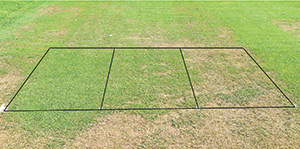A lesser of two weevils?

ABW damage on preventative (left), threshold (middle) and no-insecticide (right) treatments (not treated with paclobutrazol) on June 5, 2018, six days after threshold damage was met. (Photo: Katherine Diehl)
The annual bluegrass weevil (ABW) can inflict severe damage on annual bluegrass (Poa annua) fairways, greens and collars. Because the ABW showcases a strong preference for annual bluegrass over creeping bentgrass (Agrostis stolonifera), we hypothesized that manipulating traditional insecticide programs to allow some ABW damage might help superintendents control annual bluegrass in creeping bentgrass fairways.
In 2017 research, we observed that ABW damage to annual bluegrass was more severe in PGR-treated plots. To further explore the relationship between ABW damage and paclobutrazol, we initiated a separate experiment in 2018.
We conducted this research on a simulated fairway with a history of ABWs at Rutgers University. Treatments consisted of three insecticide programs combined with four rates of paclobutrazol. We applied paclobutrazol monthly and included rates 4, 6 and 12 fl. oz./A and a nontreated control. The first insecticide program was “preventative” and controlled the ABW at all larval stages to prevent turfgrass injury, as is standard on many golf courses where the ABW is endemic. Second was the “threshold” insecticide program, which did not offer any early larval control; we applied insecticides only after we observed threshold damage (unacceptable fairway turfgrass quality May 30, 2018). We also included a “no-insecticide” program as a scientific control. We assessed annual bluegrass cover and turfgrass quality monthly.
Preliminary results indicate that the paclobutrazol program had a greater impact on season-long annual bluegrass control than an insecticide program. Initial results also suggest that in the absence of paclobutrazol, the turfgrass quality of the “threshold” treatments was quick to recover from initial ABW damage after rescue insecticide applications were made. This experiment will be repeated in 2019.
Katherine H. Diehl, Matthew T. Elmore, Ph.D., Albrecht M. Koppenhöfer, Ph.D., and James A. Murphy, Ph.D., are turfgrass scientists at Rutgers University.










